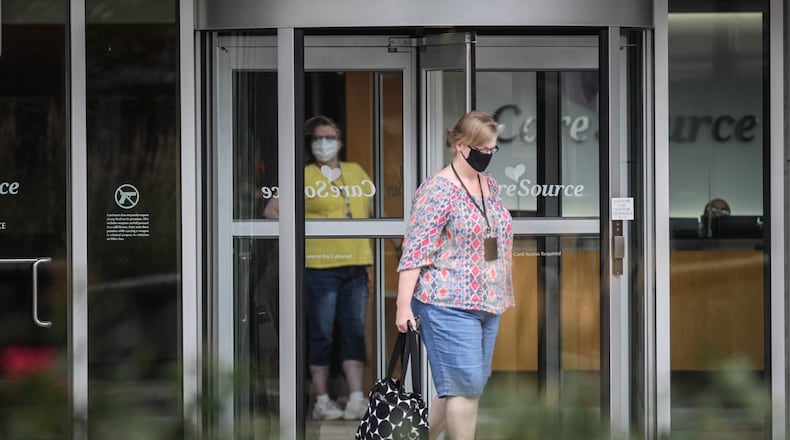The downtown-based health insurance company covers 1.8 million people between Ohio, Kentucky, Indiana, West Virginia and Georgia. It’s growth has solidified the company as one of Dayton’s largest employers, with more than 3,000 local employees. One out of every six dollars in Ohio’s general operations budget flows through CareSource, which manages over half of the Medicaid plans in the state.
In the two years since CEO Erhardt Preitauer took over, the company has had significant turnover of senior leadership and drew in national talent to fill the high ranking roles.
“Everything else we’ve talked about, it’s going to really take CareSource to the next level and take it ultimately from a big regional plan to a national plan,” Preitauer said. “That’s what we’re aspiring to be. That’s what we will become. And having the right folks in the right place I think is a key element of that.”
Preitauer said the company’s growth ambition is less about trying to hit some kind of hard number as a goal but rather about the importance of scale.
“We think the ability to grow is is actually very critical for maintaining the vitality of CareSource,” he said.
The company has already grown — and grown quickly — after the Affordable Care Act expanded their customer base, carving in a whole new population of people on Medicaid or individual plans through the newly created ACA marketplace. The company went from $3.7 billion in revenue in 2013 to $10.4 billion in 2018.
As it grew quickly, there were indications of growing pains, including several Ohio fines after previous periods of late payments to hospitals, doctors and other providers. Pharmacists started to complain in 2017 about Medicaid subcontractors paying too little for pharmacy benefits and keeping too much of the $3 billion they manage. Then in 2018, when insurers like CareSource took over managing payments for mental health and addiction care, in a large expansion of the scope of what CareSource does, there were some clashes with behavioral health providers who felt slow payments and bureaucracy were hampering their practices.
Preitauer said “there were some significant growing pains” and that’s part of why as an organization he said they’ve been working on bringing in the right skill sets and experience to do what they are doing.
He said he sees the company’s growth along three chapters, with the first chapter focused on stability and fundamentals.
“And I think when the organization had grown significantly, it took its off the ball for a little while, and the fundamentals got a little shaky. It happens. And that’s okay. So we’ve tightened that up and now with being among the highest quality best operating plans, it’s clear that we’ve done an amazing job there,” Preitauer.
He said the next chapter after stability is to get to the building capability phase, which includes CareSource’s overhaul of how it manages pharmacy benefits, upgrading and getting the right people in place in the company.
“It’s really positioning the company and getting its cost position right, getting this quality position,” he said.
The third chapter, which is where he sees them at now, is getting into new states and growing the footprint of the company and its mission.
Minnesota-based analyst Allan Baumgarten, who authors the Ohio Health Market Review, which includes analyzing insurance plans in the state, said CareSource’s plans for growth raise some questions about how they will navigate the challenges.
To grow through Medicaid, which is their biggest business line, the company would need to get a state contract with a new state, which is an involved process and can sometimes mean ousting a plan with an incumbent advantage. Growing into new states through acquiring other insurance plans can be tricky for nonprofits.
Growing through Medicare Advantage likely wouldn’t make as much money but can be an easier point of entry, such as if they approach a hospital system that wants to get into the insurance business and form a joint venture as partners.
“A Medicaid contract with a new state, that’s $1 billion, maybe $2 billion, in revenue in the first year. When starting a new Medicare health plan, if you have some early success, you get maybe $100 million of revenue in the first year and you’re sharing it with your partner,” Baumgarten said. “So the possibilities are broader since there are maybe more opportunities to do this, though the revenues are not as scale-able as a Medicaid plan.”
For now, CareSource has to navigate the pandemic, which Preitauer said has slowed some of their immediate opportunities for growth.
Credit: Jim Noelker
Credit: Jim Noelker
“But we need to get past the immediate challenges we’re all faced with regarding COVID to be able to access a few different states and targets that that we had started conversations with frankly before COVID hit, well,” he said. “We’ll be announcing an additional state that we’re entering later this year so I’m excited about that ... looking ahead we’ve got big plans to expand and we’re going to do it right here from the Dayton area.”
In 2018, CareSource had $10.4 billion in revenue and said in its annual report that it spent 91% of that money back out on health care and kept about 9% for administration.
About the Author



